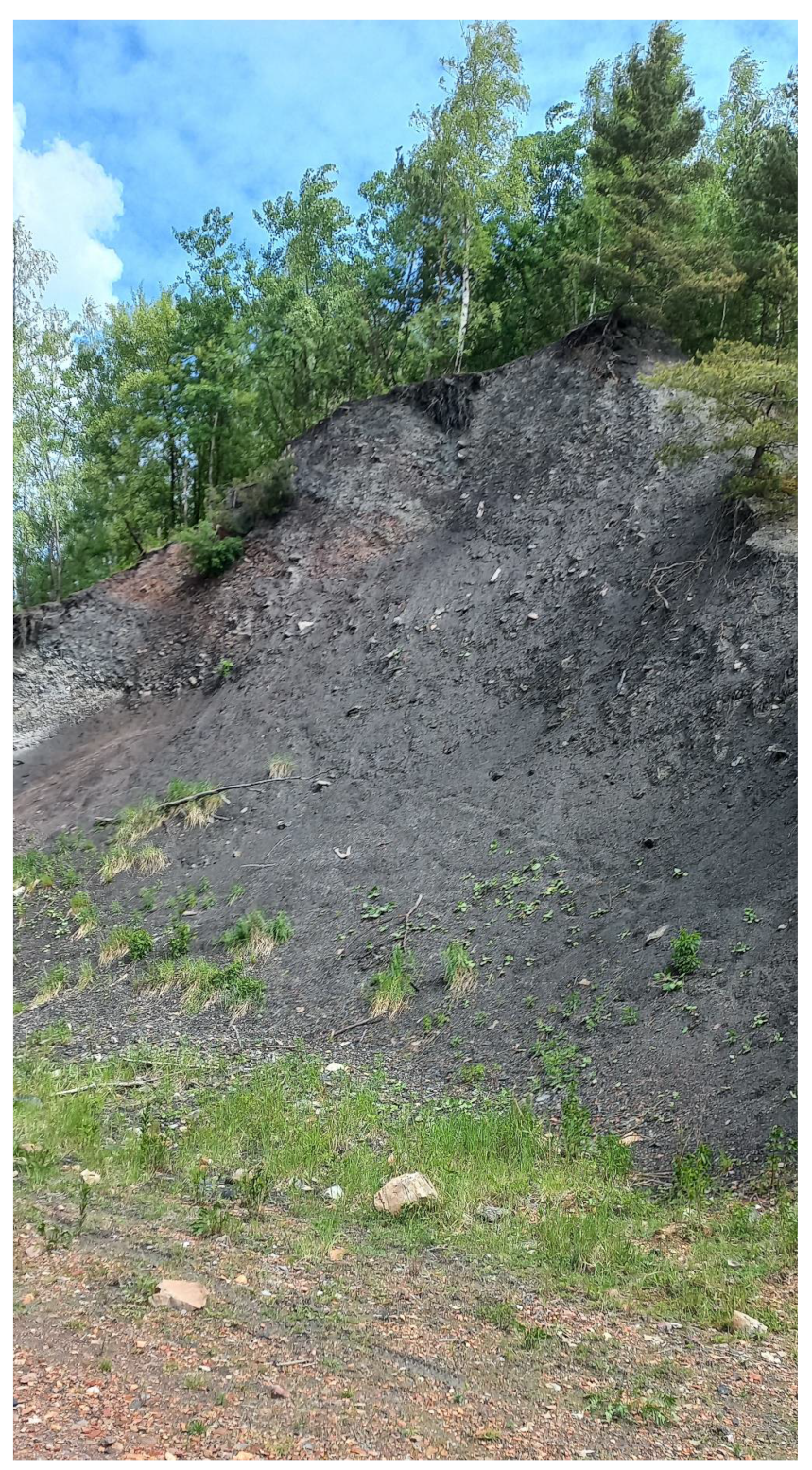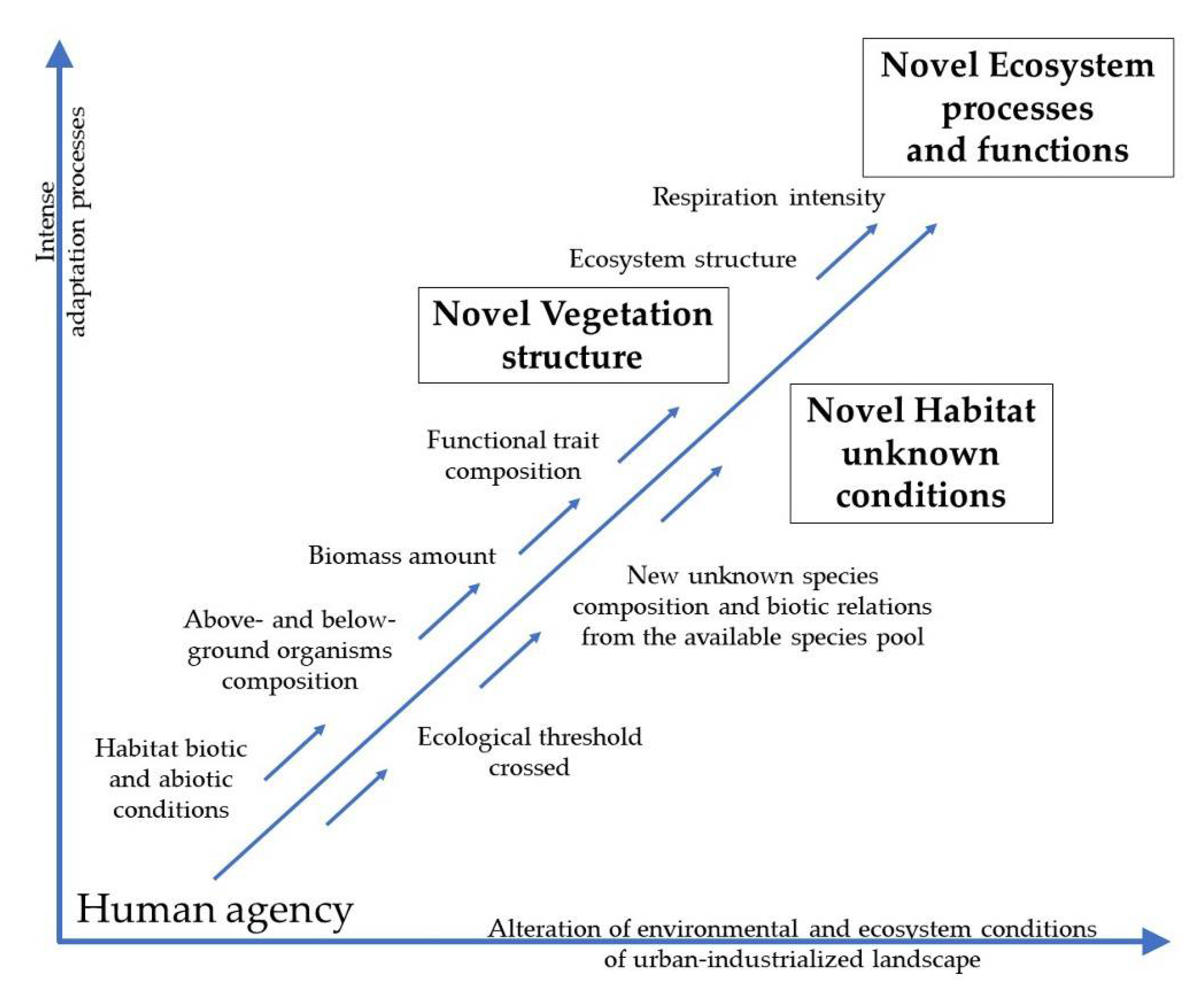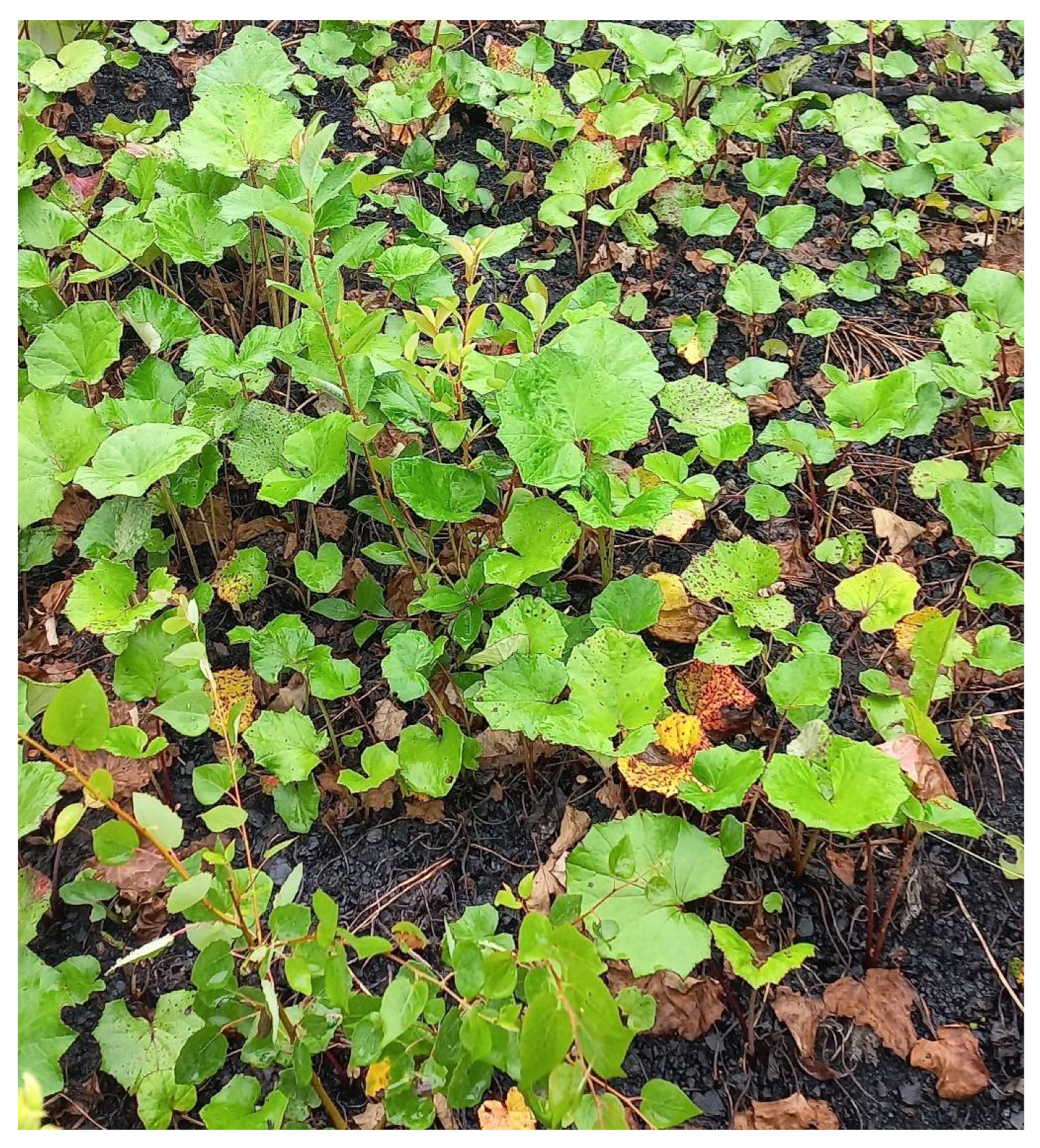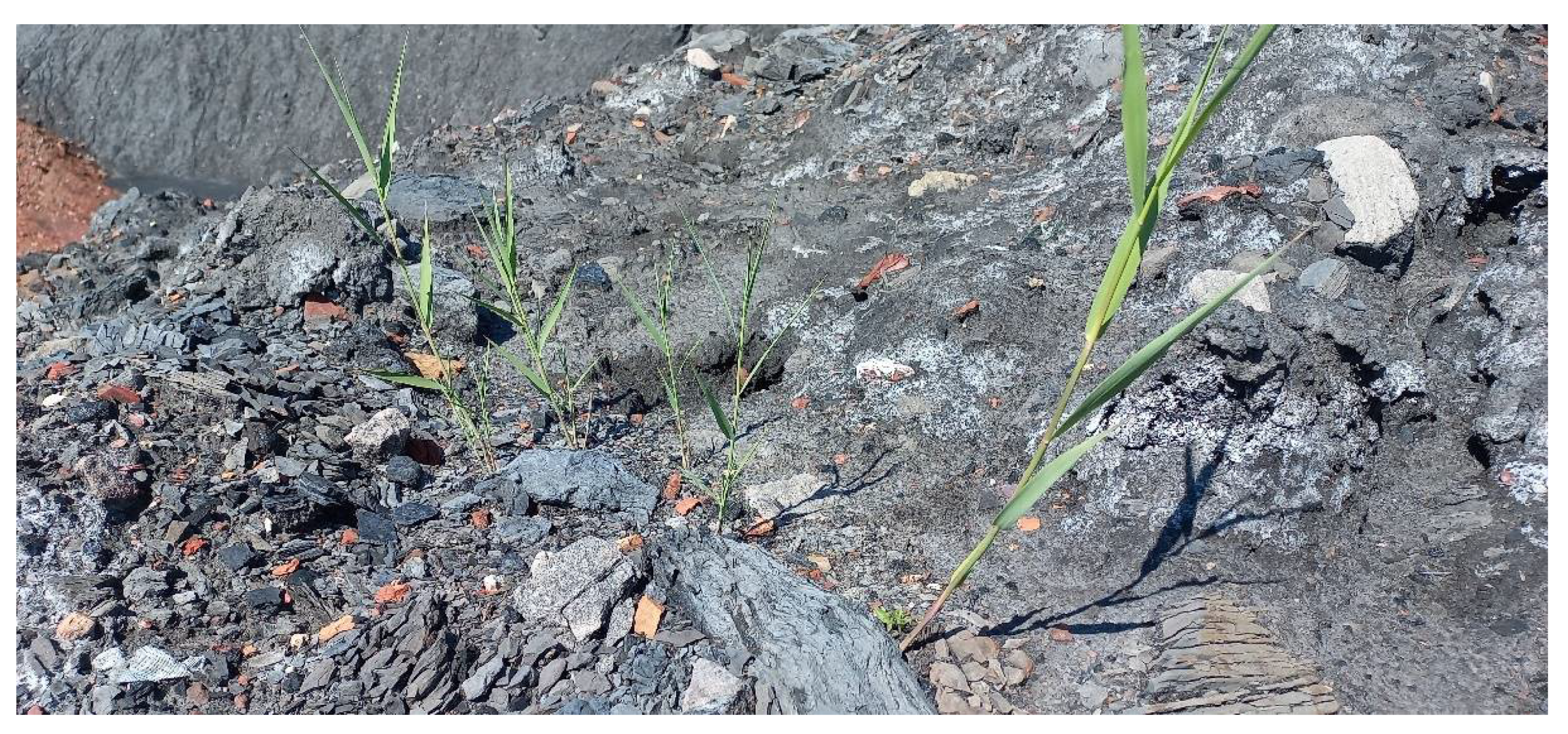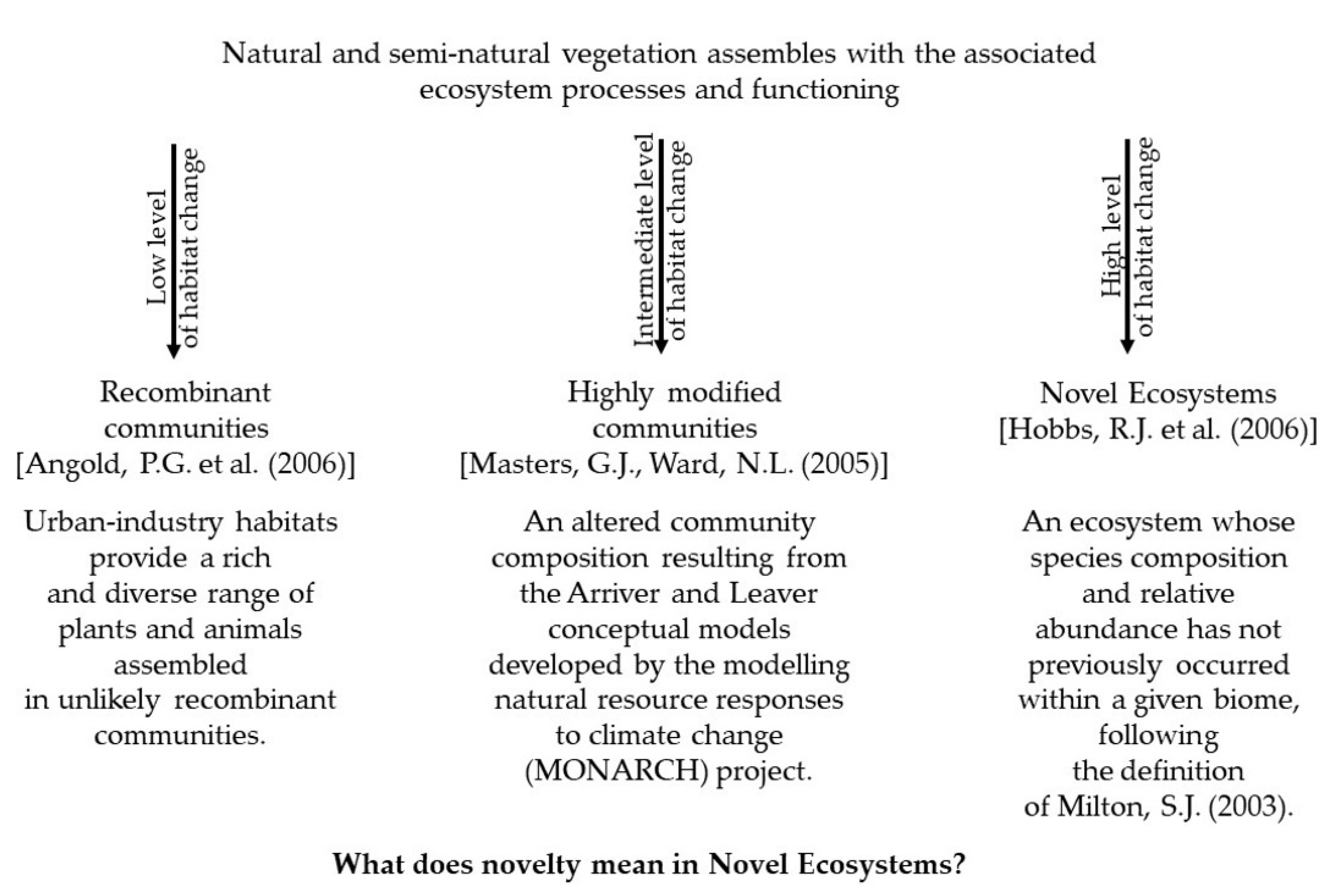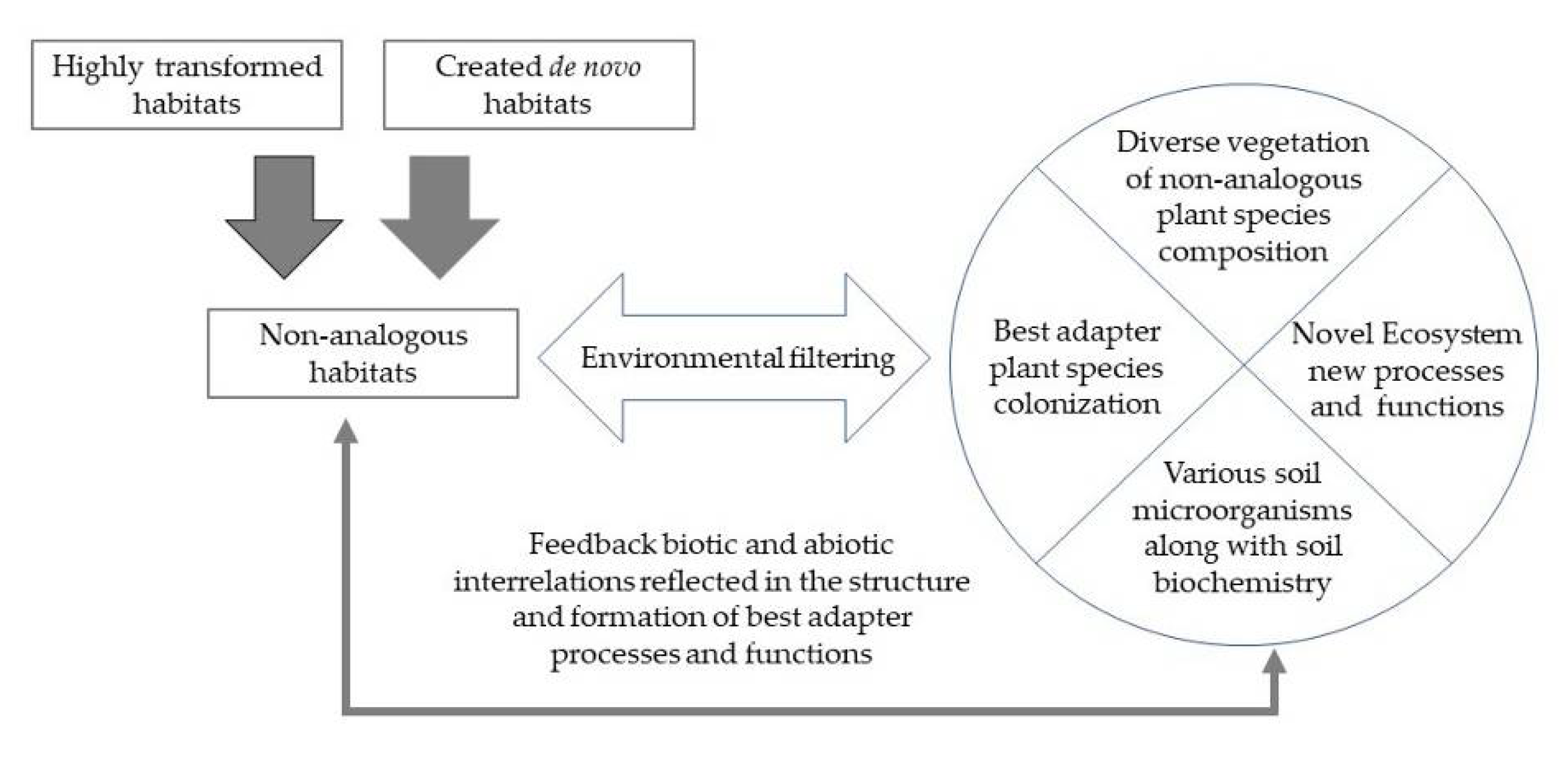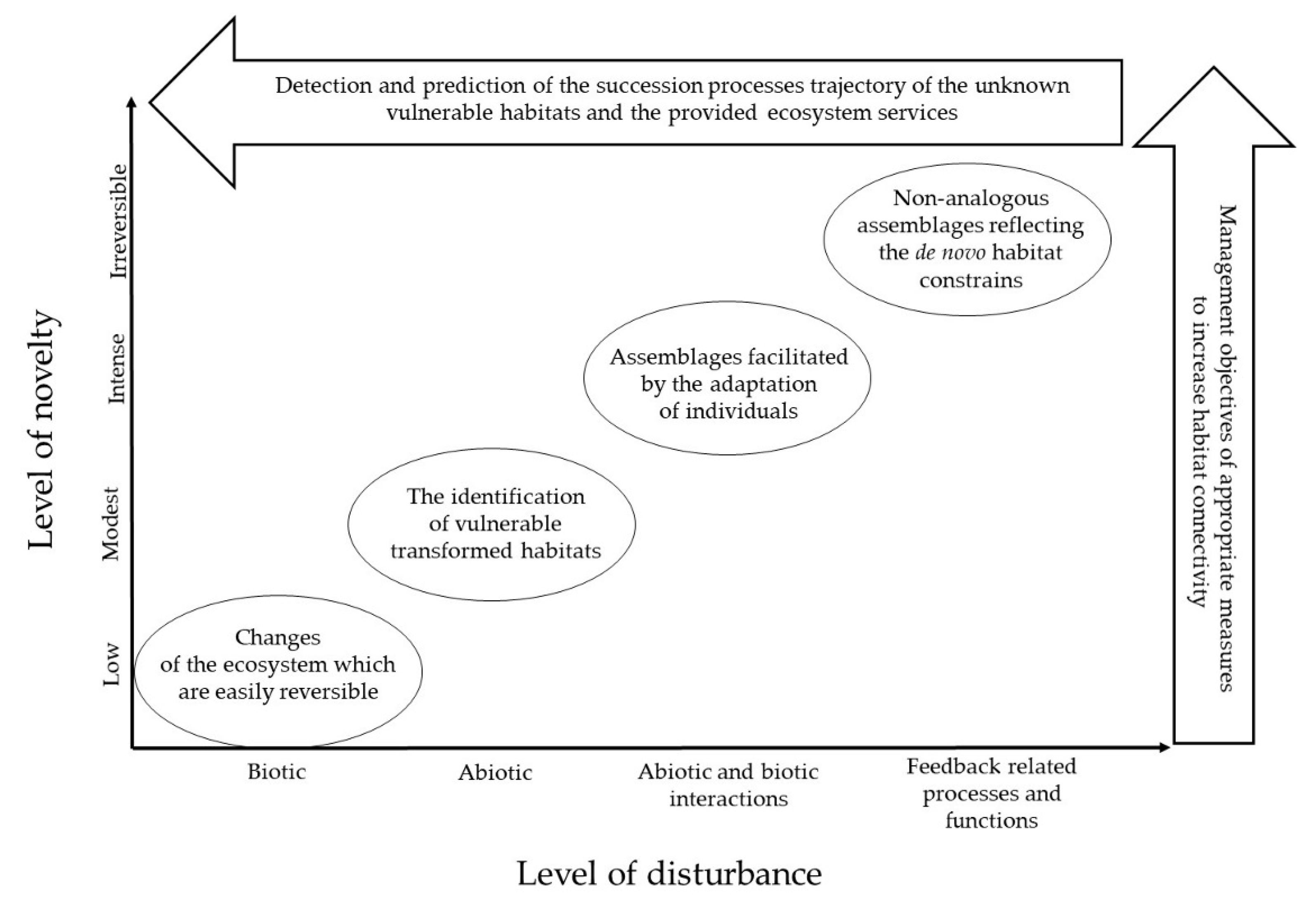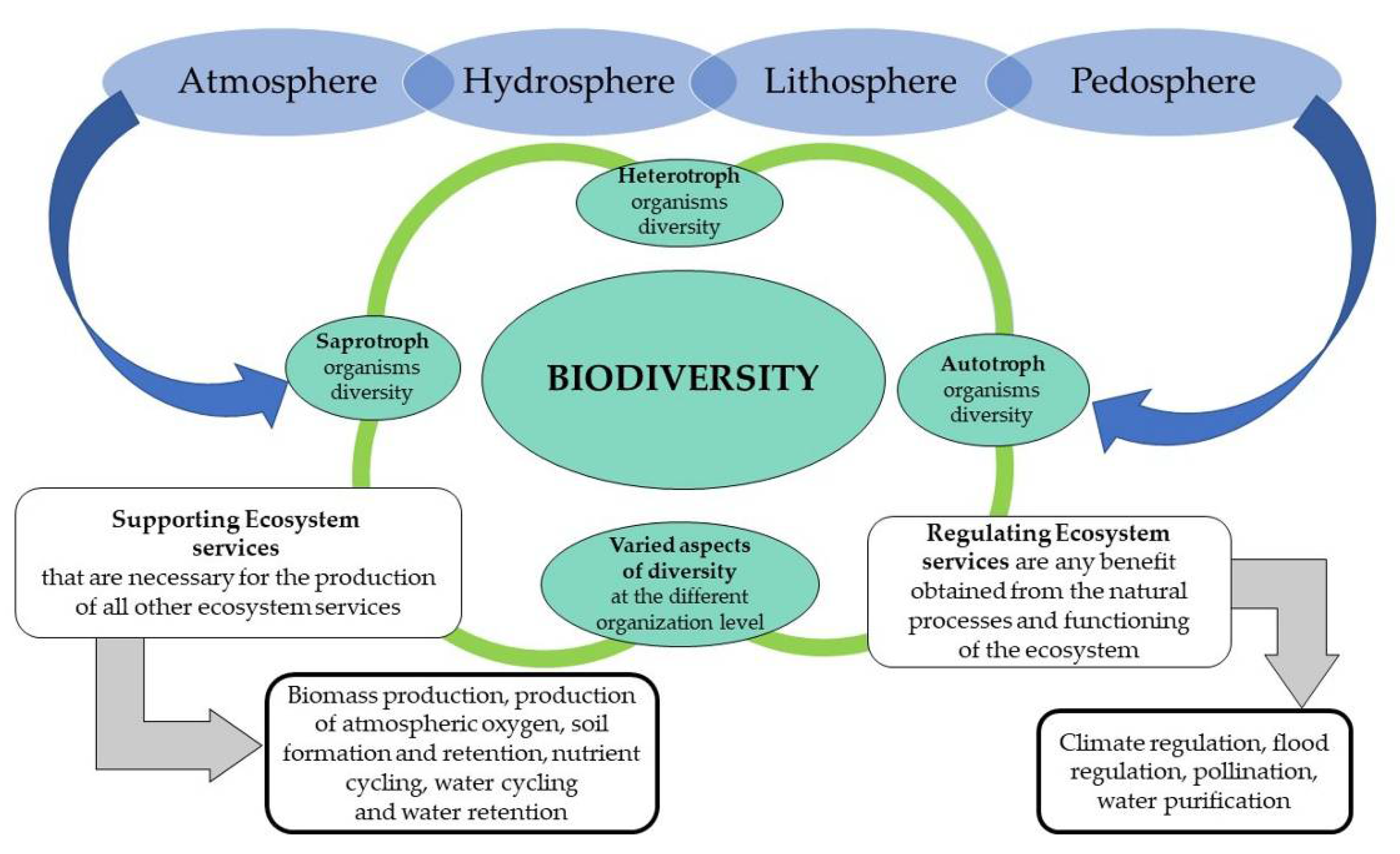1. Introduction
Urbanization, industrialization, and even agriculture cause the isolation of human beings from nature, especially wildlife. The impacts on the environment include the biophysical and biochemical conditions of habitats. This alternative modifies biodiversity changes, ecosystem processes, distributions of species occurrences, and natural resources [
1,
2,
3,
4,
5]. Humans use known solutions to solve the recorded problem, assuming that the impact of conditions is virtually constant [
6,
7]. Such an approach does not consider the possibility that natural adaptation processes respond very efficiently to different habitat constraints. The challenge today, facing global change, is to avoid the situation when one mistake is made and is followed by an attempt to replace it by another. Humans insist on cultivating and arranging most terrestrial and wetland areas instead of observing natural processes. Identifying and understanding the adaptation of natural processes on different levels affords an ability to enhance them [
8,
9].
For decades, the phrase “environmental protection” has been used frequently, and each official document must include a note about this idea [
10,
11]. Regardless of this, the global environmental situation seems to be getting worse. The consideration that it is time to change the approach significantly should be made: observe, identify, understand, and enhance the natural multi-level comprehensive processes related to many feedbacks, as they are the most efficient and optimal in most environmental constraints [
12].
One of the impacts of human activity is the alteration of landscapes by removing vegetation, resulting in areas left as open land. Sometimes areas of large spatial extent in the urban-industrial landscape are changed or established de novo. For many years, the practices of restoration and reclamation were everyday activities. The point was to repair the environment after urban or industrial transformation. In many European countries, attempts by restoration ecologists to reverse changes caused by human activity and bring land back to its previous state have been unsuccessful [
6,
7]. The lack of success in restoration and reclamation activities has caused many restoration ecologists to conclude that some ecosystems were changed so drastically that it is not feasible to restore them to their previous state [
8,
9]. Sites that are seriously changed, or sites that emerged de novo, provide new, unknown habitat conditions for developing a Novel Ecosystem [
10,
11,
12].
Research has shown that the traditional approach to restoration activities and restoration methods does not apply to Novel Ecosystem habitats. Most reclamation activities ignore the latest biological and environmental knowledge and bring harm instead of improving the environmental functioning of the ecosystem mosaic [
6,
11]. The restoration of Novel Ecosystems in the traditional restoration approach is impossible because of the lack of reference ecosystems with which Novel Ecosystems can be compared. Such habitat conditions do not exist in natural and semi-natural habitats and ecosystems [
13].
Regardless of the magnitude of development and technology, humans and societies strictly depend on nature and ecosystem services. Everything that is used by, and that surrounds, people comes from nature, from the abiotic and biotic elements of ecosystems. The environment consists of a mosaic of ecosystems in varying stages of development and transformation. The common feature of all ecosystems is many feedback relationships that connect abiotic and biotic elements. The ecosystem processes and functions provide ecosystem services [
14]. Maintaining and enhancing biological and ecosystem processes in urban and industrialized areas are important, as they provide ecosystem services [
15].
In addition to natural processes, the interference caused by human activity leads to the crossing of environmental thresholds, resulting in the emergence of Novel Ecosystems [
16]. There is a lack of natural and semi-natural reference sites [
12]. The understanding and recognition of the processes governing the development and functioning of Novel Ecosystems is immensely important [
11,
12].
This paper aims to review the different aspects of the appearance of Novel Ecosystems in urban-industrial landscapes, to consider and characterize some of the biological and ecosystem processes and functions, particular biodiversity, as crucial elements contributing to ecosystem services in the urban-industrial landscape. This paper also tries to underline the lack of knowledge on topics that should be studied to take advantage of the natural processes given to us, and to help encourage ecosystem services in a changing environment.
2. Material and Methods
We looked for the literature based on the published data and our field observations (also published earlier). The articles were found using the different databases of peer-reviewed journal articles (e.g., Google Scholar, Scopus, Web of Science, or Science Direct). We want to emphasize that there is rich and exciting literature related to the following keywords: restoration ecology, ecosystem processes and functioning, disturbed habitats, post-mineral excavation sites, human-transformed landscape, and Anthropocene Epoch. However, we selected the most relevant publications, which refer to our subject of inter-est. We wanted to use the latest scientific literature from different countries. We wanted to broaden the background of our article to refer to other contexts outside our country. Furthermore, the projects indicated in the “Funding” section are connected with the subject of our article because these projects refer to sites with Novel Ecosystems.
3. Results and Discussion
3.1. Novel Ecosystem in Urban and Industrialized Areas
Novel Ecosystems are new ecological entities to be identified and understood. They are governed by their own specific biological and environmental rules on specific sites [
8,
9,
17]. Five prerequisite conditions characterize a site assigned as a Novel Ecosystem habitat: (i) the habitat was established due to human agents; (ii) the Novel Ecosystem is growing in a non-analogous manner not found in natural and semi-natural habitats; (iii) the organisms, most importantly plant and animal species composition, are unknown (non-analogous—[
10,
18,
19]) in existing ecosystems; (iv) the Novel Ecosystem is developing further as an autonomous, independent system after the human agent stops action; (v) the specific sites of Novel Ecosystems can establish a self-maintaining system composed of specific abiotic and adapted biotic elements and processes.
The establishment and expanded occurrence of Novel Ecosystems on many sites (
Figure 1) have implied many challenges and possibilities simultaneously, specifically in environmental sciences, social sciences, and the economy.
Novel Ecosystems are an assemblage of organisms that have colonized unique abiotic conditions set up due to human (human agency) transformation. The environmental changes must be intense enough to cross an ecological threshold (
Figure 2). As a result, the particular site moves into a new ecosystem trajectory [
13]. The return to a previous course of ecosystem development is impossible regardless of the lack of continuing human disturbance. Novel Ecosystems have self-sustaining ecosystem functioning. The Novel Ecosystem comprises the best-adapted organisms, filtered by specific biogeochemical feedback relationships. As a result, particular processes, and consequently ecosystem functioning, are reflected in the related ecosystem services [
8].
An essential aspect of a Novel Ecosystem is the apparent plant trait adaptations caused by human-induced rapid environmental change (HIREC). The new unknown ecological processes and parameters influence the responses of plants and other organisms, and lead to new compositions determined by the constraints of Novel Ecosystem habitats [
17,
20,
21]. The adaptations of living organisms to HIREC factors prove that the establishment of Novel Ecosystem processes can be a type of spontaneous process that is supported by the environmental changes. The adaptation processes provide many possibilities for applications [
22,
23]. Among them are the mineral post-excavation sites, e.g., opencast sandpits, post-coal-mine heaps, lead-zinc heaps, and limestone quarries [
24,
25,
26,
27]. There is a need to conduct additional studies to identify the Novel Habitats and sites and to understand how the Novel Ecosystems function in urban and industrialized areas.
3.2. What Does Novelty Mean in Novel Ecosystems?
Along with considering the introduction of the Novel Ecosystem concept by restoration ecologists, conservation biologists developed the concept of “new conservation” [
11]. Conservation biology has traditionally been mostly focused on the loss of wild places that need to stay unchanged (
Figure 3) [
1]. However, the concept of new conservation is developing worldwide, while an increasing number of areas are becoming transformed by human activities. The continuous natural biogeochemical scientific basis of an environmental study of changing habitat conditions is crucial for conservation actions. Interdisciplinary knowledge about dynamic ecosystem processes has been critical for management decision-makers [
28]. The environmental challenges of the Anthropocene allow no space and time for mistakes.
Humans are now transforming and shaping the planet so much that this is a living geological record. The new geological epoch is the Anthropocene [
29]. The scientific basis of nature protection, “old conservation”, should be expanded. Apart from its focus on identifying and establishing protected areas, conservation should include the management of places transformed by human agency, specified based on research results for their ecosystem benefits. The same considerations by restoration ecologists are necessary [
30]. There is a growing number of sites where restoration to the permeable, historical stage is impossible. Hobbs’ idea of the Novel Ecosystem has provided the conceptual framework for many fieldwork observations and the results of studies conducted on the spontaneous assembling of plant species, vegetation patches, and the development of ecosystem mosaics on post-mineral excavation sites in the urban-industrial landscape (
Figure 4) [
31].
This might be a way to move cooperation among restoration ecologists forward by removing the false dichotomy between the Novel Ecosystem’s existence and the new conservation approach versus the old one. The contradiction might be the main point that has been lost—the understanding of the vital distinction between change and novelty. When considering novelty, specificity is necessary: a Novel Ecosystem related to what and in which aspects, including the degree of novelty [
4,
32]. The novelty might be considered the degree of dissimilarity of a system, assessed or measured in one or more aspects, relative to a reference pattern or baseline defined both in space and time (
Figure 1,
Figure 3 and
Figure 4).
Novelty and change are different. Humans have changed many places on the planet in many ways. Some sites have been changed more or created de novo, e.g., by open and deep mining of mineral resources. Not all changes result in novelty. The answer to the question “novel in which way?” depends on the particular question. However, the distinction between biotic and abiotic novelty is a crucial issue [
33,
34]. Abiotic novelty may unavoidably lead to biotic novelty, but not necessarily vice versa—biotic novelty does not always cause abiotic novelty (
Figure 5). The critical point is that it is not meaningful to talk about novelty in an ecosystem without being specific about what is novel [
35].
To respond to the question about “novel relative to what?”, it is necessary to specify which aspect of an ecosystem is novel. The novelty can be assessed when the reference baseline in both space and time is defined for comparison. The increasing knowledge about the development and functioning of Novel Ecosystems can improve the quality of environmental and ecosystem mosaic functioning, life of the dense human urban population, and offer cost-effective solutions to global challenges. Knowledge about Novel Ecosystems in urban-industrial areas plays a crucial role in protecting biodiversity and enhancing nature’s ability to provide essential ecosystem services [
36,
37].
The identification, understanding, and enhancement of the natural processes in Novel Habitats and Novel Ecosystems still needs to be developed.
3.3. Novel Ecosystems of Post-Excavation Sites and Their Environmental Processes and Functions
Novel Ecosystem theory and practice can partially solve the current environmental challenges. The comprehensive introduction of the Novel Ecosystem idea into the decision-making process of managers and practitioners can provide an optimal solution to environmental ecosystem mosaic problems of the urban-industrial areas. Updated applied management actions and implications must be linked to Novel Ecosystem theory and the concept of ecosystem services [
38,
39,
40,
41].
The scientific (biological, geological, hydrological, and hydrogeological) approach is the basis for the functioning of ecosystem and environmental processes in applied environmental and ecosystem management [
8,
42,
43]. The post-mining sites in altered landscapes are one example of Novel Ecosystem habitats [
44].
Identification of the challenges regarding the dynamic environmental transformation should be recognized by the policymakers who decide about the practitioner's actions. This task is complicated because of the biogeochemical nature of ecosystem processes. There is growing awareness of the synergetic ecological feedbacks and many multi-conditional processes of associations among organisms governed by assembly rules responding to the constraints of mineral substratum habitats. The environmental filtering concept [
45] describes the mechanisms governing the series of related operations (
Figure 6).
The processes characteristic of Novel Ecosystems have been observed and studied in post-mining sites. Mineral resource mining always causes the disturbance and alteration of the landscape [
44,
46]. The newly emerged ecosystems on post-mineral excavation sites are developing functions that provide critical ecosystem services and goods for the environment and local social community (e.g., resources for pollinators) (
Figure 7). Novel Ecosystems have vegetation types composed of new species compositions of plants in terms of taxonomic identity and plant functional types [
47]. Plant species and other autotrophic organisms, as the primary producers, are the basis and fundaments of vegetation communities, and consequently ecosystem structure and function [
48,
49]. The autotrophic organisms start the energy and matter flow system in Novel Ecosystems, followed by independent ecological self-sustaining entities. The modified environmental elements of novel systems have not been previously identified and quantified [
50]. There is still more study to be conducted.
Novel Ecosystem theory gives a new possibility for redefining the traditional relations between human activity and natural processes. A new approach to managing altered land, restoration actions, and conservation of biogeochemical processes is necessary [
51,
52]. The interdisciplinary environmental research approach will enable the identification and understanding of the adaptation processes and evolutionary potentials resulting from the ways in which Novel Ecosystems function to enhance the more appropriate management considerations [
10,
13,
17,
30,
53,
54,
55,
56]. The interdisciplinary approach is focused on environmental studies concerned with using a range of possible practical and strategic opportunities to enhance ecosystem and environmental functioning for the environmental profit of social transformation [
4,
55,
57,
58].
The new ecosystems that have spontaneously emerged on post-exploitation landscapes present functional ecosystems that serve as crucial environmental goods for the local community. The unique composition of autotrophic organisms, primarily plants, as the primary producers, causes a change in the vegetation communities, ecosystem structure, processes, and function of Novel Ecosystems [
48]. The new biological and environmental systems have not been previously carefully identified, quantified, and assessed as potentially new ecosystem services [
49]. An essential aspect of the functioning of many Novel Ecosystems is the occurrence of rare, endangered, and protected plant species in developing vegetation patches. Most of these species represent the poor oligotrophic, mineral, dry, and wetland habitats. A large body of research on the spontaneous occurrence of species considered rare or endangered in such habitats has been conducted [
59,
60].
Research on the relationships of the biotic and abiotic elements of established Novel Ecosystems is becoming more common. The increasing number of studies focused on Novel Ecosystem processes and functioning provides evidence that the possibilities of applying the obtained knowledge will be beneficial for urban-industrial environments. The development of environmental knowledge is more effective. Instead of considering the non-feasible attempt of restoration to a historical stage, the ecological approach should be implied, which seems to be the only rational solution for some sites in the urban-industrial and post-excavation landscape [
6,
44]. Environmental scientists should study the vegetation patch assembly process and the subsequent ecosystem development in Novel Habitats.
3.4. Ecosystem Services in Urban-Industrial Landscapes
Ecosystem services are profits and benefits for humans and societies obtained from biological and ecosystem processes and functions [
61]. Some ecosystem services are direct and obvious, e.g., the provision of services. According to the Millennium Ecosystem Assessment Report on Ecosystems and Human Well-Being-Biodiversity Synthesis [
62], the provisioning and aesthetic values are direct ecosystem services. The regulating ecosystem services represent the indirect ecosystem services such as flood prevention, air cleaning, noise reduction, water filtration and purification, carbon storage and carbon dioxide sequestration, and various aspects of biodiversity [
3,
37]. All of the above services are related to biogeochemical and ecosystem processes and functions. The crucial point is the enhancement and support of natural, spontaneous processes (
Figure 8).
Human life and social relationships depend directly on ecosystem services (including prominent items such as water and food). Ecosystem services are only possible due to ecosystem mosaic processes and functioning. At the same time, there is an increased understanding that biodiversity, particularly plant species diversity, and functional diversity must be recognized at various levels (alpha, beta, and gamma) [
63]. All the related ecosystem services can significantly improve the quality of ecosystem processes and environmental functioning in industrialized and urban areas [
56].
The multiple relationships between biological and ecological processes and ecosystem services are not fully recognized or understood in Novel Ecosystems and are not always considered a priority by people responsible for policy-making in urban-industrialized landscapes [
8,
9].
3.5. Socio-Economic Approach
Ecosystem services provision in industrialized and urban areas depends on the diversity among and within patches that compose ecosystem mosaics in industrialized and urban landscapes. Many of the socio-economic relationships to the official environmental constraints, and the potential of Novel Ecosystems with natural adaptation processes, are presented by Jagodziński and Woźniak [
64]. The expression quality and quantity of the so-called urban green infrastructure is used in the socio-economic approach (omitting the prerequisite habitat and environmental processes underlying the natural processes behind water, wetland, and terrestrial vegetation and ecosystem). However, the fundamental aspect of Novel Ecosystems is missing in this concept. Some ideas refer to a green-blue infrastructure, the water, the enhancement of wetland habitats, and supporting management. In the engineer's approach, a green-blue infrastructure includes gardens, parks, urban allotments, urban tree stands, lakes, and ponds in cities. The expression "infrastructure" suggests some technical and planned solutions, while the natural spontaneous biological and ecosystem processes are underestimated and sometimes ignored or even neglected. Even though there is still a need to enhance natural processes, decision-makers cannot introduce appropriate actions into the management practices (
Figure 9).
The possible reason for that might be the lack of current environmental knowledge or the availability of ongoing scientific assistance. The long history of adaptation and evolutionary processes proves that biological processes are the only ones that are capable of optimizing the solutions—via the responses of living organisms and their assemblages to abiotic constraints and the changing environmental conditions [
64].
Interdisciplinary studies by biologists, sociologists, economists, and decision-makers are necessary to find a way to introduce the newest research results to management activities via a biogeochemical environmental approach. Probably never before has the introduction of results of scientific study into everyday practice been so crucial for so many people across so many areas: economy, sociology, and the improvement of environmental conditions [
51,
52].
Research has shown that the old approach to restoration activity and restoration methods does not apply to Novel Ecosystem habitats. Most reclamation activities ignore the newest biological and environmental knowledge and cause harm instead of improving the ecosystem and environmental functioning [
6,
11,
65,
66]. The restoration of Novel Ecosystems in the old restoration approach is impossible because of the lack of reference ecosystems. Such habitat conditions do not exist in natural and semi-natural habitats and ecosystems [
13].
There are papers showing that Novel Ecosystems are reservoirs for many varied ecosystem processes and functions [
17,
40,
67,
68]. The findings of a recent study suggest that the species composition of novel vegetation assemblages and resulting ecosystem processes can be crucial in climate change mitigation [
69]. The human-induced habitats established de novo in the urban-industrial landscape enhance the ecosystem mosaic and enable the occurrence of rare species in secondary biotopes [
70]. The increasing biodiversity of an ecosystem will be reflected in the critical ecosystem function [
69,
71,
72]. The new species assemblages are established due to the unique above- and belowground soil substratum features followed by the associated interactions and adaptation processes [
22].
Interdisciplinary studies are necessary to work out a framework of constant environmental, ecological, sociological, and economic cooperation towards enhancing the natural processes because of their environmental, social, and economic values.
3.6. Novel Ecosystem Habitats and Biodiversity Ecosystem Functioning (BEF)
Biodiversity is the diversity of all living organisms and their variety. In many papers, the diversity of plants of the particular ecosystem are presented or compared [
73]. Plants and other primary producers play a unique role in initiating the organic matter cycling in the ecosystem [
74,
75]. However, the understanding of the functional relationships between plant diversity and belowground organisms is limited. Interactions between plant species and microorganisms are crucial in all terrestrial ecosystems [
76,
77,
78,
79]. Ecosystem functioning depends on the relationships between microorganisms and plant roots and plant biomass, which ultimately becomes soil organic matter [
80,
81]. Microbial communities are an essential part of the saprophytes and those which are dependent on root exudates comprise the most abundant and diverse subset of the soil microbiome [
73,
74]. Belowground biodiversity is the largest resource of biological diversity on Earth [
82,
83]. In natural and semi-natural ecosystems, more studies have been dedicated to understanding the relationships between biodiversity loss and ecosystem functioning parameters reflected in the ecosystem service quality [
84]. Biodiversity influences ecosystem functions, as species functional traits determine the efficiency of ecosystem processes [
85].
Novel Ecosystems (NEs) differ in structure and function compared to the previous conditions [
11,
86]. The novelty—non-analogous plant species composition—may influence (mainly increase) the biodiversity-related ecosystem services (ESs) that indirectly or directly benefit society [
68]. There is an increasing need to understand the relationships between the concepts of biodiversity, Novel Ecosystems, and Ecosystem Services for the appropriate conservation and management (e.g., [
24,
39,
87]). The harsh habitat conditions of different Novel Ecosystem habitats cause adaptations in plants [
22]. Data about the potential of biodiversity of the Novel Ecosystem habitats and ecophysiology variety can be obtained by studying the consequences [
88].
The scientific literature initially applied to ecosystems containing “plant species composition and their relative abundances that have not occurred before within a given biome” [
10]. The discussion encompassing novelty reveals the challenge that land managers and conservation scientists face when preparing relevant and appropriate management objectives in Novel Ecosystems [
89]. Based on the papers on the no-analog species composition of ecosystems [
24] and ecosystem ecology [
12,
32], it should be emphasized that the management of Novel Ecosystems requires novel approaches [
90].
4. Conclusions
Understanding Novel Ecosystem functions and identifying Novel Habitats is necessary. Novel Ecosystems in the urban-industrial landscape are interesting aspects of environmental knowledge requiring broadening.
Furthermore, the natural processes taking place in the development of Novel Habitats and Novel Ecosystems still need to be studied, understood, and enhanced. The biological processes are optimized to adapt to environmental and habitat constraints. Additional research is necessary to identify the adaptation processes and mechanisms that have evolved in response to the changes in the biotic and abiotic relationships in the environment.
Studies aimed at understanding the mechanisms and set-up of Novel Ecosystems on post-mineral excavations sites established de novo, along with the environmental processes and functions, including the dynamic adaptation processes on the individual, population, patch, synusia, and ecosystem levels, should be conducted.
Identifying and explaining the contributions of processes and functions during matter and energy flow in modified, transformed, and Novel Ecosystems to the provision of ecosystem services, are key issues and provide future perspectives for environmental scientists.
It needs to be highlighted that interdisciplinary studies (the environmental, ecological, sociological, and economic aspects) should be conducted towards the goal of enhancing the natural processes in environmental management because of their ecosystem ecology, social, and economic values.
Author Contributions
Conceptualization, A.H., G.W. and A.M.J.; validation, D.C., A.M.J., A.H. and G.W.; formal analysis, D.C., A.M.J., A.H., A.D. and G.W.; resources, G.W.; writing—original draft preparation, A.H. and G.W.; writing—review and editing, A.H. and A.M.J.; visualization, A.H., A.D. and G.W.; supervision, G.W.; project administration, A.H. and A.D.; funding acquisition, G.W. and A.M.J. All authors have read and agreed to the published version of the manuscript.
Funding
This research was funded by The National Centre for Research and Development, Grant Number: NCN 6P04G05312 (Convergence and divergence of vegetation on the Carboniferous rocks); TANGO1/268600/NCBR/2015 (INFOREVITA – System wspomagania rewitalizacji zwałowisk odpadów pogórniczych przy użyciu narzędzi geoinformatycznych/ Geoinformatics tools a supporting system of coal mine heaps reclamation), the National Science Centre Poland, Grant Number: OPUS 2017/25/B/NZ8/02449 (Ocena zależności pomiędzy funkcjonalną różnorodnością roślin, strukturą zespołów mikroorganizmów i bilans węgla w czasie spontanicznej sukcesji na terenach poprzemysłowych z wykorzystaniem analiz metatranskryptomicznych), and OPUS 2019/35/B/ST10/04141 (Linking soil substrate biogeochemical properties and spontaneous succession on post-mining areas: novel ecosystems in a human-transformed landscape).
Institutional Review Board Statement
Not applicable.
Informed Consent Statement
Not applicable.
Data Availability Statement
Not applicable.
Acknowledgments
We would like to thank Lee Frelich (University of Minnesota, Minneapolis, MN, USA) for language support and corrections.
Conflicts of Interest
The authors declare that there is no conflict of interest.
References
- Hawksworth, D.L.; Bull, A.T. (Eds.) Biodiversity and Conservation in Europe; Springer: Dordrecht, The Netherlands, 2008; pp. 1–439. [Google Scholar]
- Sahney, S.; Benton, M.J.; Ferry, P.A. Links between global taxonomic diversity, ecological diversity and the expansion of vertebrates on land. Biol. Lett. 2010, 6, 544–547. [Google Scholar] [CrossRef] [PubMed]
- Mace, G.M.; Norris, K.; Fitter, A.H. Biodiversity and ecosystem services: A multilayered relationship. Trends Ecol. Evol. 2012, 27, 19–26. [Google Scholar] [PubMed]
- Rotherham, I.D. Recombinant Ecology—A Hybrid Future? Springer: Cham, Switzerland, 2017; pp. 1–85. [Google Scholar]
- Wuebbles, D.J.; Fahey, D.W.; Hibbard, K.A.; DeAngelo, B.; Doherty, S.; Hayhoe, K.; Horton, R.; Kossin, J.P.; Taylor, P.C.; Waple, A.M.; et al. Executive Summary of the Climate Science Special Report: Fourth National Climate Assessment, Volume, I. In Climate Science Special Report: Fourth National Climate Assessment, Volume I; Wuebbles, D.J., Fahey, D.W., Hibbard, K.A., Dokken, D.J., Stewart, B.C., Maycock, T.K., Eds.; U.S. Global Change Research Program: Washington, DC, USA, 2017; pp. 3–26. [Google Scholar]
- Tropek, R.; Kadlec, T.; Hejda, M.; Kocarek, P.; Skuhrovec, J.; Malenovsky, I.; Vodka, S.; Spitzer, L.; Banar, P.; Konvicka, M. Technical reclamations are wasting the conservation potential of post-mining sites. A case study of black coal spoil dumps. Ecol. Eng. 2012, 43, 13–18. [Google Scholar] [CrossRef]
- Schoukens, H. Legal considerations in operationalizing eco-restoration in the European Union: A Sisyphean task or unlocking existing potential? In Ecological Restoration Law: Concepts and Case Studies; Akhtar-Khavari, A., Richardson, B.J., Eds.; Routledge: London, UK, 2019; pp. 167–192. [Google Scholar]
- Morse, N.B.; Pellissier, P.A.; Cianciola, E.N.; Brereton, R.L.; Sullivan, M.M.; Shonka, N.K.; Wheeler, T.B.; McDowell, W.H. Novel ecosystems in the Anthropocene: A revision of the novel ecosystem concept for pragmatic applications. Ecol. Soc. 2014, 19, 12. [Google Scholar] [CrossRef]
- Evers, C.R.; Wardropper, C.B.; Branoff, B.; Granek, E.F.; Hirsch, S.L.; Link, T.E.; Olivero-Lora, S.; Wilson, C. The ecosystem services and biodiversity of novel ecosystems: A literature review. Glob. Ecol. Conserv. 2018, 13, e00362. [Google Scholar] [CrossRef]
- Hobbs, R.J.; Arico, S.; Aronson, J.; Baron, J.S.; Bridgewater, P.; Cramer, V.A.; Epstein, P.R.; Ewel, J.J.; Klink, C.A.; Lugo, A.E.; et al. Novel ecosystems: Theoretical and management aspects of the new ecological world order. Glob. Ecol. Biogeogr. 2006, 15, 1–7. [Google Scholar] [CrossRef]
- Hobbs, R.J.; Higgs, E.; Harris, J.A. Novel ecosystems: Implications for conservation and restoration. Trends Ecol. Evol. 2009, 24, 599–605. [Google Scholar] [CrossRef]
- Hobbs, R.J.; Higgs, E.S.; Hall, C.M. Novel Ecosystems: Intervening in the New Ecological World Order; John Wiley & Sons: Chichester, UK, 2013; pp. 1–384. [Google Scholar]
- Hallett, L.M.; Standish, R.J.; Hulvey, K.B.; Gardener, M.R.; Suding, K.N.; Starzomski, B.M.; Murphy, S.D.; Harris, J.A. Towards a conceptual framework for novel ecosystems. In Novel Ecosystems: Intervening in the New Ecological World Order; Hobbs, R.J., Higgs, E.S., Hall, C.M., Eds.; John Wiley & Sons: Chichester, UK, 2013; pp. 16–28. [Google Scholar]
- Alexandri, E.; Jones, P. Temperature decreases in an urban canyon due to green walls and green roofs in diverse climates. Build. Environ. 2008, 43, 480–493. [Google Scholar] [CrossRef]
- Costanza, R.; d’Arge, R.; de Groot, R.; Farber, S.; Grasso, M.; Hannon, B.; Limburg, K.; Naeem, S.; O’Neill, R.V.; Paruelo, J.; et al. The value of the world's ecosystem services and natural capital. Nature 1997, 387, 253–260. [Google Scholar] [CrossRef]
- Woźniak, G.; Jagodziński, A.M. Post-mineral Excavation Sites as Novel Ecosystems and Examples of Socio-environmental Resilience. In Green Scenarios: Mining Industry Responses to Environmental Challenges of the Anthropocene Epoch—International Mining Forum 2021; Dyczko, A., Jagodziński, A.M., Woźniak, G., Eds.; CRC Press Balkema, Taylor & Francis Group: Boca Raton, FL, USA, 2022; pp. 57–67. [Google Scholar]
- Perring, M.P.; Standish, R.J.; Hobbs, R.J. Incorporating novelty and novel ecosystems into restoration planning and practice in the 21st century. Ecol. Process. 2013, 2, 18. [Google Scholar]
- Keith, S.A.; Newton, A.C.; Herbert, R.J.H.; Morecroft, M.D.; Bealey, C.E. Non-analogous community formation in response to climate change. J. Nat. Conserv. 2009, 17, 228–235. [Google Scholar] [CrossRef]
- Veloz, S.D.; Williams, J.W.; Blois, J.L.; He, F.; Otto-Bliesner, B.; Liu, Z. No-analog climates and shifting realized niches during the late quaternary: Implications for 21st-century predictions by species distribution models. Glob. Chang. Biol. 2012, 18, 1698–1713. [Google Scholar] [CrossRef]
- Kueffer, C.; Daehler, C.C. A habitat-classification framework and typology for understanding, valuing and managing invasive species impacts. In Management of Invasive Weeds; Inderjit, Ed.; Springer: New York, NY, USA, 2009; Volume 5, pp. 77–101. [Google Scholar]
- Jackson, S.T. Perspective: Ecological novelty is not new. In Novel Ecosystems: Intervening in the New Ecological World Order; Hobbs, R.J., Higgs, E.S., Hall, C.M., Eds.; John Wiley & Sons: Chichester, UK, 2013; pp. 61–65. [Google Scholar]
- Milewska-Hendel, A.; Chmura, D.; Wyrwał, K.; Kurczyńska, E.U.; Kompała-Bąba, A.; Jagodziński, A.M.; Woźniak, G. Cell wall epitopes in grasses of different novel ecosystem habitats on post-industrial sites. Land Degrad. Dev. 2021, 32, 1680–1694. [Google Scholar] [CrossRef]
- Szuba, A.; Ratajczak, E.; Kasprowicz-Maluśki, A.; Pers-Kamczyc, E. Plant Responses to Harsh Conditions of Post-industrial Habitats. In Green Scenarios: Mining Industry Responses to Environmental Challenges of the Anthropocene Epoch—International Mining Forum 2021; Dyczko, A., Jagodziński, A.M., Woźniak, G., Eds.; CRC Press Balkema, Taylor & Francis Group: Boca Raton, FL, USA, 2022; pp. 275–299. [Google Scholar]
- Williams, J.W.; Jackson, S.T. Novel climates, no-analog communities and ecological surprises. Front. Ecol. Environ. 2007, 5, 475–482. [Google Scholar] [CrossRef]
- Chen, I.-C.; Hill, J.K.; Ohlemüller, R.; Roy, D.B.; Thomas, C.D. Rapid range shifts of species associated with high levels of climate warming. Science 2011, 333, 1024–1026. [Google Scholar] [CrossRef] [PubMed]
- Yamano, H.; Sugihara, K.; Nomura, K. Rapid poleward range expansion of tropical reef corals in response to rising sea surface temperatures. Geophys. Res. Lett. 2011, 38, L04601. [Google Scholar] [CrossRef]
- Grimm, N.B.; Chapin III, F.S.; Bierwagen, B.; Gonzalez, P.; Groffman, P.M.; Luo, Y.; Melton, F.; Nadelhoffer, K.; Pairis, A.; Raymond, P.A.; et al. The impacts of climate change on ecosystem structure and function. Front. Ecol. Environ. 2013, 11, 474–482. [Google Scholar] [CrossRef]
- Balmford, A.; Bruner, A.; Cooper, P.; Costanza, R.; Farber, S.; Green, R.E.; Jenkins, M.; Jefferiss, P.; Jessamy, V.; Madden, J.; et al. Economic reasons for conserving wild nature. Science 2002, 297, 950–953. [Google Scholar] [CrossRef]
- Crutzen, P.J.; Stoermer, E.F. The ‘Anthropocene’ (2000). In Paul J. Crutzen and the Anthropocene: A New Epoch in Earth’s History; Benner, S., Lax, G., Crutzen, P.J., Pöschl, U., Lelieveld, J., Brauch, H.G., Eds.; The Anthropocene: Politik—Economics—Society—Science Springer: Cham, Switzerland, 2021; Volume 1, pp. 19–21. [Google Scholar]
- Harris, J.A.; Hobbs, R.J.; Higgs, E.; Aronson, J. Ecological restoration and global climate change. Restor. Ecol. 2006, 14, 170–176. [Google Scholar] [CrossRef]
- de Groot, R.S.; Alkemade, R.; Braat, L.; Hein, L.; Willemen, L. Challenges in integrating the concept of ecosystem services and values in landscape planning, management and decision making. Ecol. Complex. 2010, 7, 260–272. [Google Scholar] [CrossRef]
- Rosenzweig, M.L. Win-Win Ecology: How the Earth’s Species Can Survive in the Midst of Human Enterprise; Oxford University Press: Oxford, UK, 2003; pp. 1–211. [Google Scholar]
- Angold, P.G.; Sadler, J.P.; Hill, M.O.; Pullin, A.; Rushton, S.; Austin, K.; Small, E.; Wood, B.; Wadsworth, R.; Sanderson, R.; et al. Biodiversity in urban habitat patches. Sci. Total Environ. 2006, 360, 196–204. [Google Scholar] [CrossRef]
- Masters, G.J.; Ward, N.L. Implications for the Composition of Species Communities. In Modelling Natural Resource Responses to Climate Change (MONARCH): A Local Approach—Development of a Conceptual and Methodological Framework for Universal Application; Berry, P.M., Harrison, P.A., Dawson, T.P., Walmsley, C.A., Eds.; UKCIP Technical Report; UKCIP: Oxford, UK, 2005; pp. 68–73. [Google Scholar]
- Milton, S.J. ‘Emerging ecosystems’—A washing-stone for ecologists, economists and sociologists? S. Afr. J. Sci. 2003, 99, 404–406. [Google Scholar]
- Maes, J.; Paracchini, M.L.; Zulian, G.; Dunbar, M.B.; Alkemade, R. Synergies and trade-offs between ecosystem service supply, biodiversity, and habitat conservation status in Europe. Biol. Conserv. 2012, 155, 1–12. [Google Scholar] [CrossRef]
- Ricketts, T.H.; Watson, K.B.; Koh, I.; Ellis, A.M.; Nicholson, C.C.; Posner, S.; Richardson, L.L.; Sonter, L.J. Disaggregating the evidence linking biodiversity and ecosystem services. Nat. Commun. 2016, 7, 1–8. [Google Scholar] [CrossRef] [PubMed]
- Bridgewater, P.; Higgs, E.S.; Hobbs, R.J.; Jackson, S.T. Engaging with novel ecosystems. Front. Ecol. Environ. 2011, 9, 423. [Google Scholar] [CrossRef]
- Graham, N.A.J.; Cinner, J.E.; Norström, A.V.; Nyström, M. Coral reefs as novel ecosystems: Embracing new futures. Curr. Opin. Env. Sust. 2014, 7, 9–14. [Google Scholar] [CrossRef]
- Perring, M.P.; Audet, P.; Lamb, D. Novel ecosystems in ecological restoration and rehabilitation: Innovative planning or lowering the bar? Ecol. Process. 2014, 3, 8. [Google Scholar] [CrossRef]
- Dooling, S.E. Novel landscapes: Challenges and opportunities for educating future ecological designers and restoration practitioners. Ecol. Restor. 2015, 33, 96–110. [Google Scholar] [CrossRef]
- Robbins, P.; Moore, S.A. Ecological anxiety disorder: Diagnosing the politics of the Anthropocene. Cult. Geogr. 2013, 20, 3–19. [Google Scholar] [CrossRef]
- Murcia, C.; Aronson, J.; Kattan, G.; Moreno-Mateos, D.; Dixon, K.; Simberloff, D. A critique of the “novel ecosystem” concept. Trends Ecol. Evol. 2014, 29, 548–553. [Google Scholar] [CrossRef]
- Doley, D.; Audet, P. Adopting novel ecosystems as suitable rehabilitation alternatives for former mine sites. Ecol. Process. 2013, 2, 22. [Google Scholar] [CrossRef]
- Kraft, N.J.B.; Adler, P.B.; Godoy, O.; James, E.C.; Fuller, S.; Levine, J.M. Community phylogenetics and ecosystem functioning: Community assembly, coexistence and the environmental filtering metaphor. Funct. Ecol. 2015, 29, 592–599. [Google Scholar] [CrossRef]
- Woźniak, G. Zróżnicowanie Roślinności na Zwałach Pogórniczych Górnego Śląska; Instytut Botaniki im. W. Szafera PAN: Kraków, Poland, 2010; pp. 1–320. [Google Scholar]
- Woźniak, G.; Chmura, D.; Błońska, A.; Tokarska-Guzik, B.; Sierka, E. Applicability of Functional Groups Concept in Analysis of Spatiotemporal Vegetation Changes on Manmade Habitats. Pol. J. Environ. Stud. 2011, 20, 623–631. [Google Scholar]
- Martínez, O.J.A.; Rodríguez, M.A.; Rosario, I.; Soto, N.; López, A.; Lugo, A.E. Structure and species composition of novel forests dominated by an introduced species in northcentral Puerto Rico. New For. 2010, 39, 1–18. [Google Scholar] [CrossRef]
- Lin, B.B.; Petersen, B. Resilience, regime shifts and guided transition under climate change: Examining the practical difficulties of managing continually changing systems. Ecol. Soc. 2013, 18, 28. [Google Scholar] [CrossRef]
- Higgs, E.; Falk, D.A.; Guerrini, A.; Hall, M.; Harris, J.; Hobbs, R.J.; Jackson, S.T.; Rhemtulla, J.M.; Throop, W. The changing role of history in restoration ecology. Front. Ecol. Environ. 2014, 12, 499–506. [Google Scholar] [CrossRef]
- Marris, E. Rambunctious Garden: Saving Nature in a Post-Wild World; Bloomsbury: New York, NY, USA, 2011; pp. 1–224. [Google Scholar]
- Yung, L.; Schwarze, S.; Carr, W.; Chapin III, F.S.; Marris, E. Engaging the public in novel ecosystems. In Novel Ecosystems: Intervening in the New Ecological World Order; Hobbs, R.J., Higgs, E.S., Hall, C.M., Eds.; John Wiley & Sons: Chichester, UK, 2013; pp. 247–256. [Google Scholar]
- Seastedt, T.R.; Hobbs, R.J.; Suding, K.N. Management of novel ecosystems: Are novel approaches required? Front. Ecol. Environ. 2008, 6, 547–553. [Google Scholar] [CrossRef]
- Stafford Smith, D.M.; Abel, N.; Walker, B.; Chapin III, F.S. Drylands: Coping with uncertainty, thresholds, and changes in state. In Principles of Ecosystem Stewardship; Chapin, F.S., III, Kofinas, G.P., Folke, C., Eds.; Springer: New York, NY, USA, 2009; pp. 171–195. [Google Scholar]
- Bridgewater, P.; Yung, L. The policy context: Building laws and rules that embrace novelty. In Novel Ecosystems: Intervening in the New Ecological World Order; Hobbs, R.J., Higgs, E.S., Hall, C.M., Eds.; John Wiley & Sons: Chichester, UK, 2013; pp. 272–283. [Google Scholar]
- Woźniak, G.; Sierka, E.; Wheeler, A. Urban and Industrial Habitats: How Important They Are for Ecosystem Services. In Ecosystem Services and Global Ecology; Hufnagel, L., Ed.; IntechOpen: London, UK, 2018; pp. 169–194. Available online: https://www.intechopen.com/chapters/61054 (accessed on 9 June 2022).
- Hulvey, K.B.; Standish, R.J.; Hallett, L.M.; Starzomski, B.M.; Murphy, S.D.; Nelson, C.R.; Gardener, M.R.; Kennedy, P.L.; Seastedt, T.R.; Suding, K.N. Incorporating novel ecosystems into management frameworks. In Novel Ecosystems: Intervening in the New Ecological World Order; Hobbs, R.J., Higgs, E.S., Hall, C.M., Eds.; John Wiley & Sons: Chichester, UK, 2013; pp. 157–171. [Google Scholar]
- Light, A.; Thompson, A.; Higgs, E.S. Valuing novel ecosystems. In Novel Ecosystems: Intervening in the New Ecological World Order; Hobbs, R.J., Higgs, E.S., Hall, C.M., Eds.; John Wiley & Sons: Chichester, UK, 2013; pp. 257–268. [Google Scholar]
- Woźniak, G. The Potential of Post-Excavation Novel Ecosystems of Enhancing Vegetation and Rare Plant Species Diversity, Influencing the Ecosystem Services Provision. J. Mining. Mech. Eng. 2021, 1, 138–145. [Google Scholar]
- Bacler-Żbikowska, B.; Nowak, T. Role of Post-industrial Sites in Maintaining Species Diversity of Rare, Endangered and Protected Vascular Plant Species on the Example of the Urban-Industrial Landscapes. In Green Scenarios: Mining Industry Responses to Environmental Challenges of the Anthropocene Epoch—International Mining Forum 2021; Dyczko, A., Jagodziński, A.M., Woźniak, G., Eds.; CRC Press Balkema, Taylor & Francis Group: Boca Raton, FL, USA, 2022; pp. 245–263. [Google Scholar]
- Adams, W.M. The value of valuing nature. Science 2014, 346, 6209. [Google Scholar] [CrossRef]
- MEA—Millennium Ecosystem Assessment. In Ecosystems and Human Well-Being: Biodiversity Synthesis; World Resources Institute: Washington, DC, USA, 2005; Available online: https://www.millenniumassessment.org/documents/document.354.aspx.pdf (accessed on 15 February 2022).
- Cadotte, M.W.; Carscadden, K.; Mirotchnick, N. Beyond species: Functional diversity and the maintenance of ecological processes and services. J. Appl. Ecol. 2011, 48, 1079–1087. [Google Scholar] [CrossRef]
- Jagodziński, A.M.; Woźniak, G. Environmental Knowledge and Understanding: An Important and Necessary Aspect of Corporate Social Responsibility. In Green Scenarios: Mining Industry Responses to Environmental Challenges of the Anthropocene Epoch—International Mining Forum 2021; Dyczko, A., Jagodziński, A.M., Woźniak, G., Eds.; CRC Press Balkema, Taylor & Francis Group: Boca Raton, FL, USA, 2022; pp. 303–311. [Google Scholar]
- Bullock, J.M.; Aronson, J.; Newton, A.C.; Pywell, R.F.; Rey-Benayas, J.M. Restoration of ecosystem services and biodiversity: Conflicts and opportunities. Trends Ecol. Evol. 2011, 26, 541–549. [Google Scholar] [CrossRef] [PubMed]
- Dyczko, A.; Ryś, K.; Radosz, Ł.; Woźniak, G. Current Reclamation Practices and their Successfulness. In Green Scenarios: Mining Industry Responses to Environmental Challenges of the Anthropocene Epoch—International Mining Forum 2021; Dyczko, A., Jagodziński, A.M., Woźniak, G., Eds.; CRC Press Balkema, Taylor & Francis Group: Boca Raton, FL, USA, 2022; pp. 361–371. [Google Scholar]
- Chapin III, F.S.; Lovecraft, A.L.; Zavaleta, E.S.; Nelson, J.; Robards, M.D.; Kofinas, G.P.; Trainor, S.F.; Peterson, G.D.; Huntington, H.P.; Naylor, R.L. Policy strategies to address sustainability of Alaskan boreal forests in response to a directionally changing climate. Proc. Natl. Acad. Sci. USA 2006, 103, 16637–16643. [Google Scholar] [CrossRef] [PubMed]
- Collier, M.J.; Devitt, C. Novel ecosystems: Challenges and opportunities for the Anthropocene. Anthr. Rev. 2016, 3, 231–242. [Google Scholar] [CrossRef]
- Zedler, J.B.; Doherty, J.M.; Miller, N.A. Shifting restoration policy to address landscape change, novel ecosystems, and monitoring. Ecol. Soc. 2012, 17, 36. [Google Scholar] [CrossRef] [Green Version]
- Chmura, D.; Molenda, T.; Błońska, A.; Woźniak, G. Sites of leachate inflows on coalmine heaps as refuges of rare mountainous species. Pol. J. Environ. Stud. 2011, 20, 551–557. [Google Scholar]
- Moyle, P.B. Novel aquatic ecosystems: The new reality for streams in California and other mediterranean climate regions. River Res. Appl. 2014, 30, 1335–1344. [Google Scholar] [CrossRef]
- Trueman, M.; Standish, R.J.; Hobbs, R.J. Identifying management options for modified vegetation: Application of the novel ecosystems framework to a case study in the Galapagos Islands. Biol. Conserv. 2014, 172, 37–48. [Google Scholar] [CrossRef]
- Prach, K.; Walker, L.R. Comparative Plant Succession among Terrestrial Biomes of the World; Cambridge University Press: Cambridge, UK, 2020; pp. 1–300. [Google Scholar]
- Bardgett, R.D.; van der Putten, W.H. Belowground biodiversity and ecosystem functioning. Nature 2014, 515, 505–511. [Google Scholar] [CrossRef]
- Frouz, J. (Ed.) Soil Biota and Ecosystem Development in Post Mining Sites; CRC Press, Taylor & Francis Group: Boca Raton, FL, USA, 2014; pp. 1–316. [Google Scholar]
- Ladd, J.N. Soil enzymes. In Soil Organic Matter and Biological Activity; Vaughan, D., Malcolm, R.E., Eds.; Martinus Nijhoff, Dr W. Junk Publishers: Dordrecht, Holland; Boston, MA, USA; Lancaster, UK, 1985; pp. 176–222. [Google Scholar]
- Marx, D.H.; Marrs, L.F.; Cordell, C.E. Practical use of the mycorrhizal fungal technology in forestry, reclamation, arboriculture, agriculture, and horticulture. Dendrobiology 2002, 47, 27–40. [Google Scholar]
- Frouz, J.; Prach, K.; Pižl, V.; Háněl, L.; Starý, J.; Tajovský, K.; Materna, J.; Balík, V.; Kalčík, J.; Řehounková, K. Interactions between soil development, vegetation and soil fauna during spontaneous succession in post mining sites. Eur. J. Soil Biol. 2008, 44, 109–121. [Google Scholar] [CrossRef]
- Kałucka, I.L.; Jagodziński, A.M. Successional traits of ectomycorrhizal fungi in forest reclamation after surface mining and agricultural disturbances: A review. Dendrobiology 2016, 76, 91–104. [Google Scholar] [CrossRef]
- Frouz, J.; Pižl, V.; Tajovský, K. The effect of earthworms and other saprophagous macrofauna on soil microstructure in reclaimed and un-reclaimed post-mining sites in Central Europe. Eur. J. Soil Biol. 2007, 43, S184–S189. [Google Scholar] [CrossRef]
- Wall, D.H.; Bardgett, R.D.; Behan-Pelletier, V.; Herrick, J.E.; Jones, T.H.; Ritz, K.; Six, J.; Strong, D.R.; van der Putten, W.H. (Eds.) Soil Ecology and Ecosystem Services; Oxford University Press: Oxford, UK, 2012; pp. 1–424. [Google Scholar]
- Wardle, D.A. Communities and Ecosystems: Linking the Aboveground and Belowground Components; Princeton University Press: Princeton, NJ, USA, 2002; pp. 1–400. [Google Scholar]
- Decaëns, T. Macroecological patterns in soil communities. Global Ecol. Biogeogr. 2010, 19, 287–302. [Google Scholar] [CrossRef]
- Cardinale, B.J.; Duffy, J.E.; Gonzalez, A.; Hooper, D.U.; Perrings, C.; Venail, P.; Narwani, A.; Mace, G.M.; Tilman, D.; Wardle, D.A.; et al. Biodiversity loss and its impact on humanity. Nature 2012, 486, 59–67. [Google Scholar] [CrossRef] [PubMed]
- Frouz, J.; Pižl, V.; Cienciala, E.; Kalčík, J. Carbon storage in post-mining forest soil, the role of tree biomass and soil bioturbation. Biogeochemistry 2009, 94, 111–121. [Google Scholar] [CrossRef]
- Silver, W.L.; Ostertag, R.; Lugo, A.E. The potential for carbon sequestration through reforestation of abandoned tropical agricultural and pasture lands. Restor. Ecol. 2000, 8, 394–407. [Google Scholar] [CrossRef]
- Muñoz-Erickson, T.A.; Lugo, A.E.; Quintero, B. Emerging synthesis themes from the study of social-ecological systems of a tropical city. Ecol. Soc. 2014, 19, 23. [Google Scholar] [CrossRef]
- Jagodziński, A.M.; Kałucka, I. Age-related changes in leaf area index of young Scots pine stands. Dendrobiology 2008, 59, 57–65. [Google Scholar]
- Lauber, C.L.; Ramirez, K.S.; Aanderud, Z.; Lennon, J.; Fierer, N. Temporal variability in soil microbial communities across land-use types. ISME J. 2013, 7, 1641–1650. [Google Scholar] [CrossRef]
- Fierer, N.; Lennon, J.T. The generation and maintenance of diversity in microbial communities. Am. J. Bot. 2011, 98, 439–448. [Google Scholar] [CrossRef]
| Publisher’s Note: MDPI stays neutral with regard to jurisdictional claims in published maps and institutional affiliations. |
© 2022 by the authors. Licensee MDPI, Basel, Switzerland. This article is an open access article distributed under the terms and conditions of the Creative Commons Attribution (CC BY) license (https://creativecommons.org/licenses/by/4.0/).
